System Analysis: Telehealth Project for Improved Rural Healthcare
VerifiedAdded on 2023/06/16
|8
|1600
|65
Report
AI Summary
This report presents a system analysis of a Telehealth project aimed at improving healthcare access in rural areas. The project seeks to overcome geographical barriers by using information and communications technologies, such as video conferencing, to link urgent care centers with hospitals. The analysis highlights the problem of limited healthcare access in rural regions, the capabilities of Telehealth in providing remote medical advice and cost-effective solutions, and the benefits of saving time and resources for both patients and healthcare providers. The project's focus on serving rural communities, its technology-based approach, and its potential to improve patient outcomes are emphasized, ultimately concluding that Telehealth offers a significant advancement in healthcare delivery.
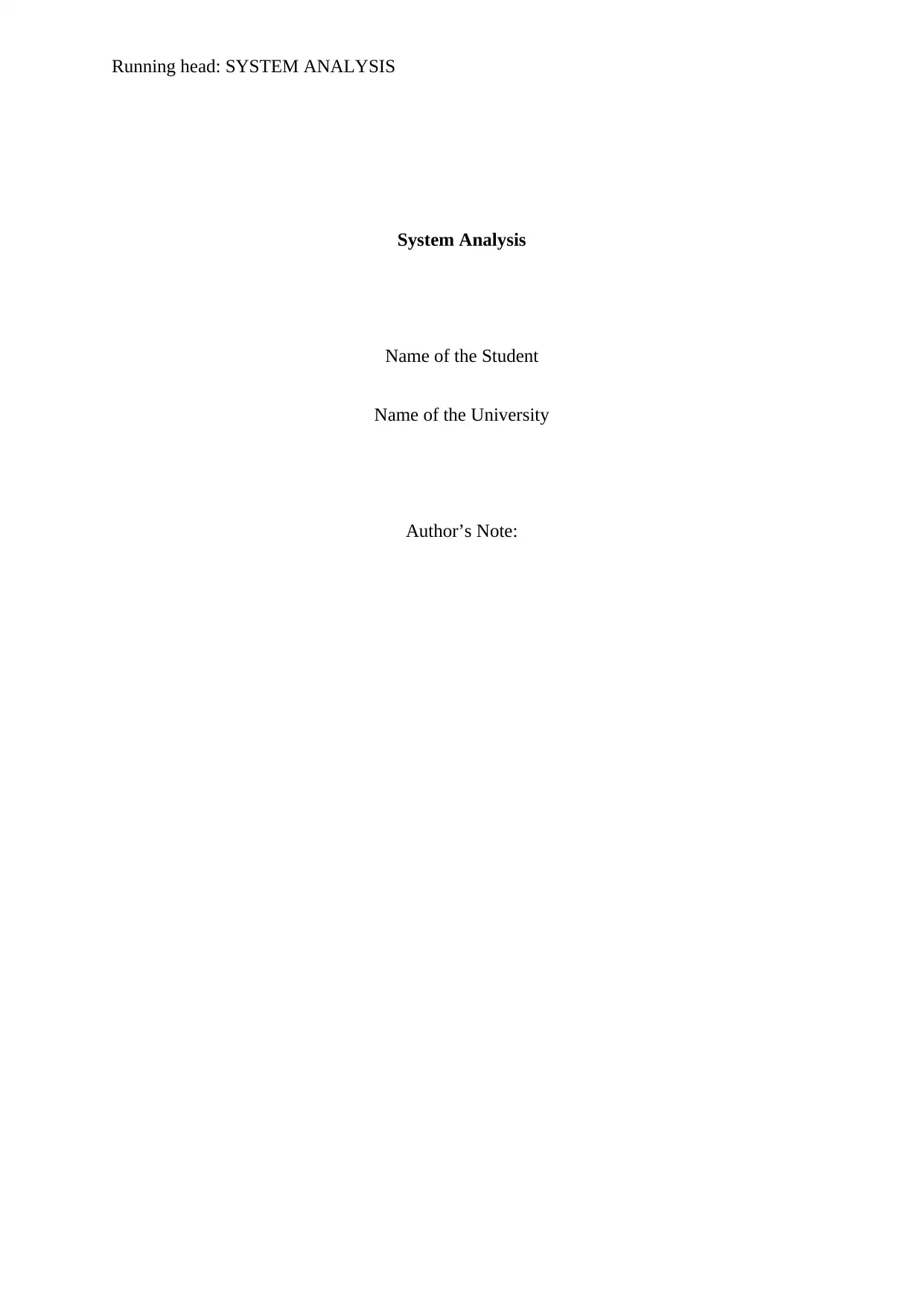
Running head: SYSTEM ANALYSIS
System Analysis
Name of the Student
Name of the University
Author’s Note:
System Analysis
Name of the Student
Name of the University
Author’s Note:
Paraphrase This Document
Need a fresh take? Get an instant paraphrase of this document with our AI Paraphraser
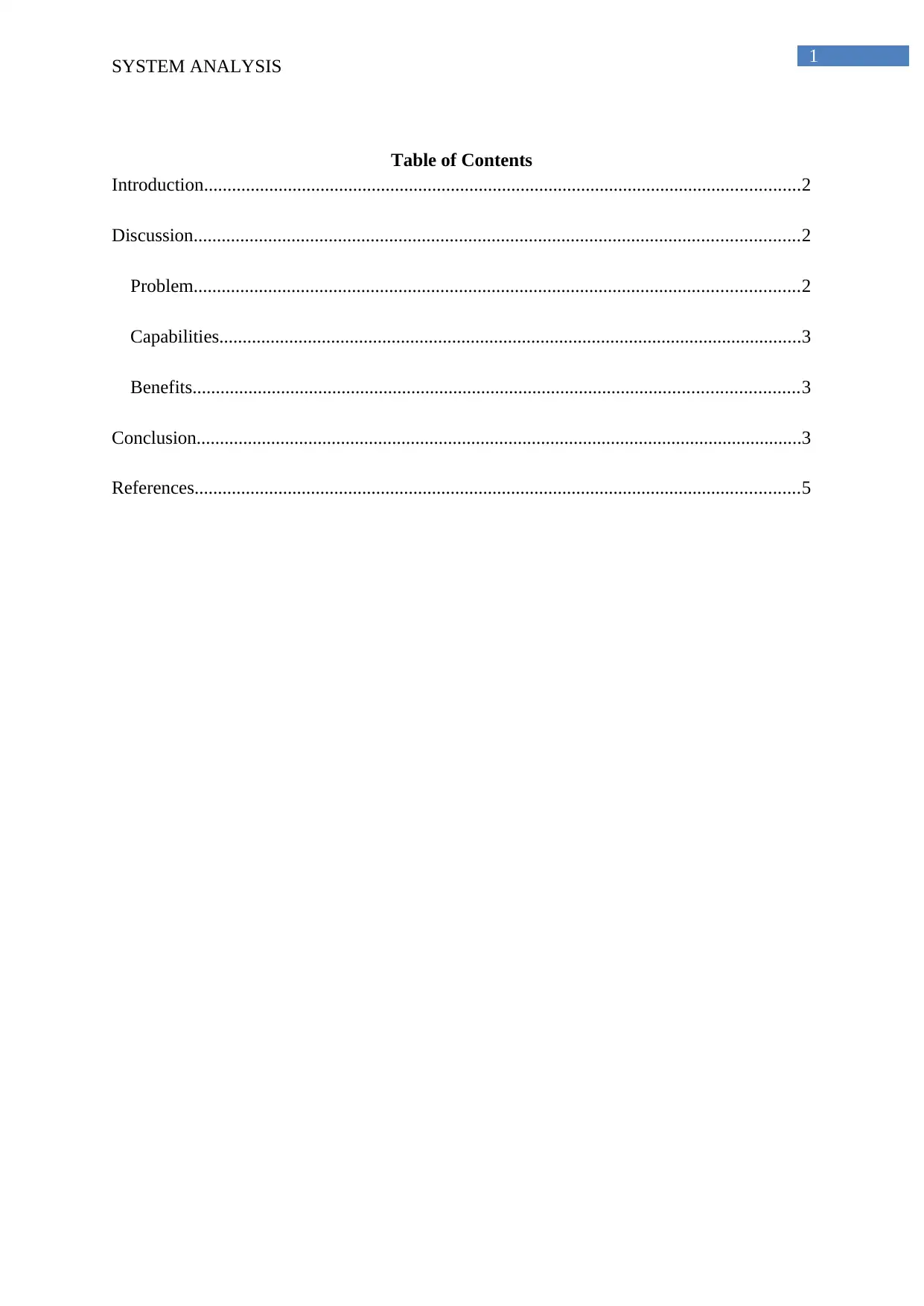
1
SYSTEM ANALYSIS
Table of Contents
Introduction................................................................................................................................2
Discussion..................................................................................................................................2
Problem..................................................................................................................................2
Capabilities.............................................................................................................................3
Benefits..................................................................................................................................3
Conclusion..................................................................................................................................3
References..................................................................................................................................5
SYSTEM ANALYSIS
Table of Contents
Introduction................................................................................................................................2
Discussion..................................................................................................................................2
Problem..................................................................................................................................2
Capabilities.............................................................................................................................3
Benefits..................................................................................................................................3
Conclusion..................................................................................................................................3
References..................................................................................................................................5
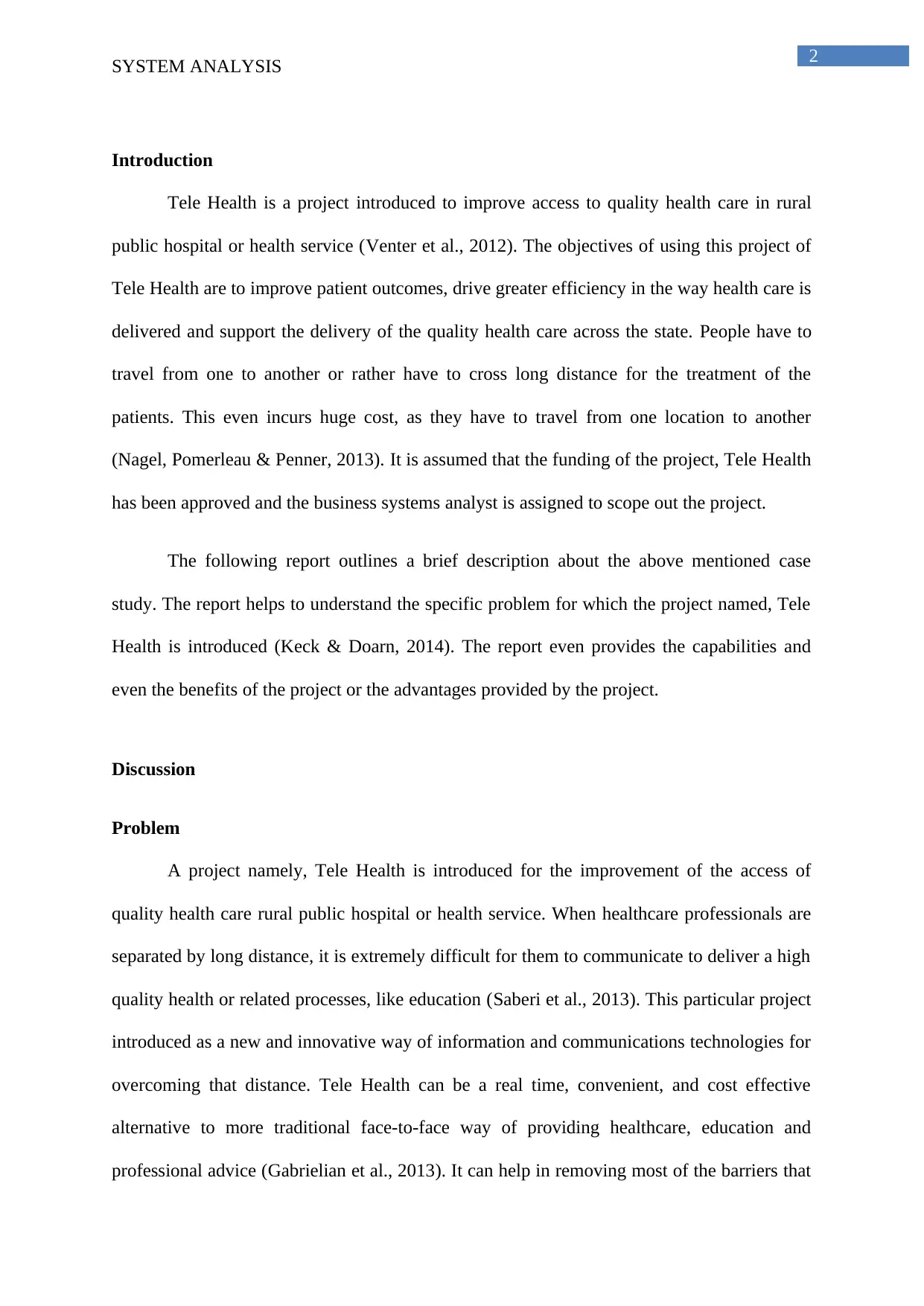
2
SYSTEM ANALYSIS
Introduction
Tele Health is a project introduced to improve access to quality health care in rural
public hospital or health service (Venter et al., 2012). The objectives of using this project of
Tele Health are to improve patient outcomes, drive greater efficiency in the way health care is
delivered and support the delivery of the quality health care across the state. People have to
travel from one to another or rather have to cross long distance for the treatment of the
patients. This even incurs huge cost, as they have to travel from one location to another
(Nagel, Pomerleau & Penner, 2013). It is assumed that the funding of the project, Tele Health
has been approved and the business systems analyst is assigned to scope out the project.
The following report outlines a brief description about the above mentioned case
study. The report helps to understand the specific problem for which the project named, Tele
Health is introduced (Keck & Doarn, 2014). The report even provides the capabilities and
even the benefits of the project or the advantages provided by the project.
Discussion
Problem
A project namely, Tele Health is introduced for the improvement of the access of
quality health care rural public hospital or health service. When healthcare professionals are
separated by long distance, it is extremely difficult for them to communicate to deliver a high
quality health or related processes, like education (Saberi et al., 2013). This particular project
introduced as a new and innovative way of information and communications technologies for
overcoming that distance. Tele Health can be a real time, convenient, and cost effective
alternative to more traditional face-to-face way of providing healthcare, education and
professional advice (Gabrielian et al., 2013). It can help in removing most of the barriers that
SYSTEM ANALYSIS
Introduction
Tele Health is a project introduced to improve access to quality health care in rural
public hospital or health service (Venter et al., 2012). The objectives of using this project of
Tele Health are to improve patient outcomes, drive greater efficiency in the way health care is
delivered and support the delivery of the quality health care across the state. People have to
travel from one to another or rather have to cross long distance for the treatment of the
patients. This even incurs huge cost, as they have to travel from one location to another
(Nagel, Pomerleau & Penner, 2013). It is assumed that the funding of the project, Tele Health
has been approved and the business systems analyst is assigned to scope out the project.
The following report outlines a brief description about the above mentioned case
study. The report helps to understand the specific problem for which the project named, Tele
Health is introduced (Keck & Doarn, 2014). The report even provides the capabilities and
even the benefits of the project or the advantages provided by the project.
Discussion
Problem
A project namely, Tele Health is introduced for the improvement of the access of
quality health care rural public hospital or health service. When healthcare professionals are
separated by long distance, it is extremely difficult for them to communicate to deliver a high
quality health or related processes, like education (Saberi et al., 2013). This particular project
introduced as a new and innovative way of information and communications technologies for
overcoming that distance. Tele Health can be a real time, convenient, and cost effective
alternative to more traditional face-to-face way of providing healthcare, education and
professional advice (Gabrielian et al., 2013). It can help in removing most of the barriers that
⊘ This is a preview!⊘
Do you want full access?
Subscribe today to unlock all pages.

Trusted by 1+ million students worldwide
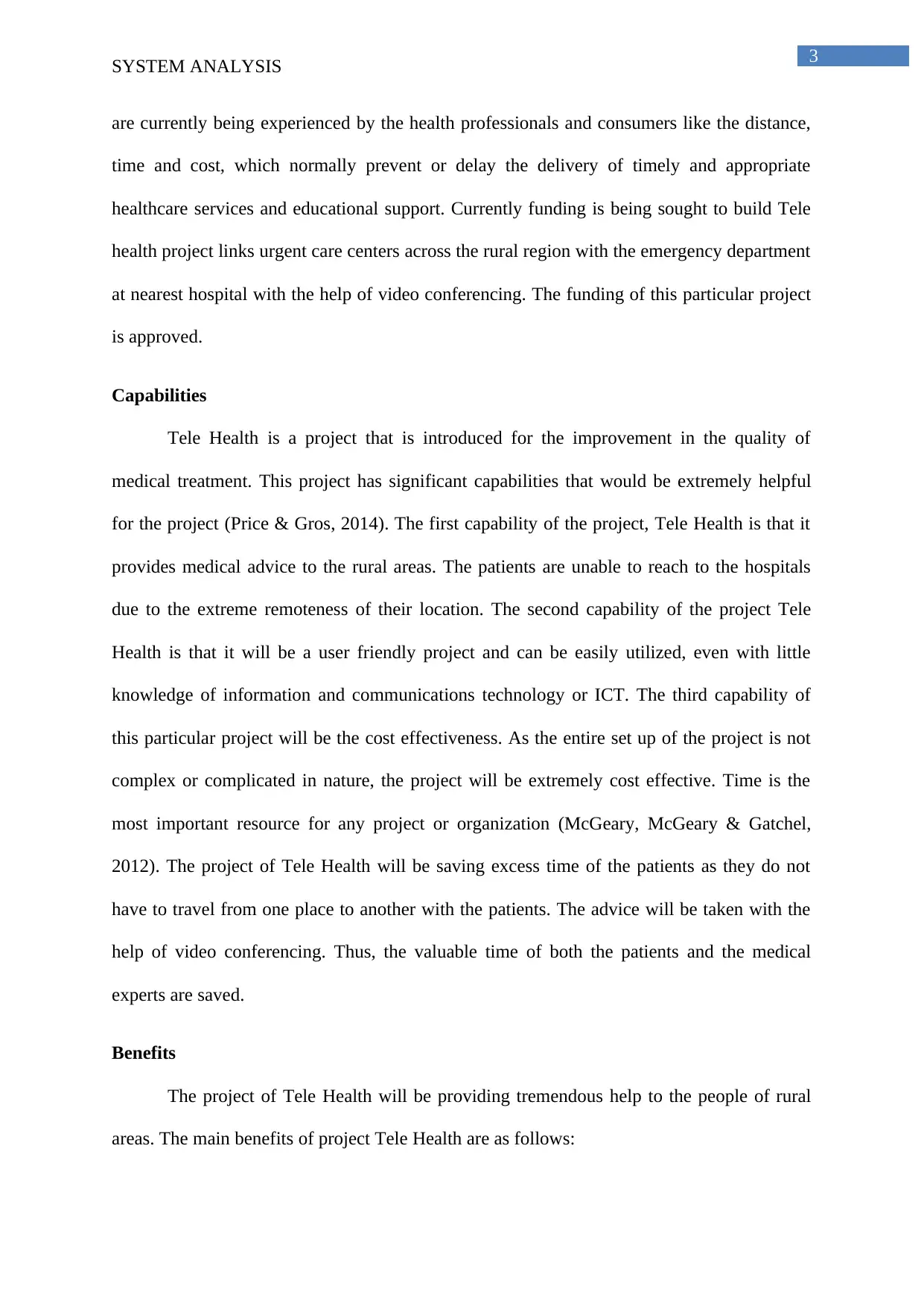
3
SYSTEM ANALYSIS
are currently being experienced by the health professionals and consumers like the distance,
time and cost, which normally prevent or delay the delivery of timely and appropriate
healthcare services and educational support. Currently funding is being sought to build Tele
health project links urgent care centers across the rural region with the emergency department
at nearest hospital with the help of video conferencing. The funding of this particular project
is approved.
Capabilities
Tele Health is a project that is introduced for the improvement in the quality of
medical treatment. This project has significant capabilities that would be extremely helpful
for the project (Price & Gros, 2014). The first capability of the project, Tele Health is that it
provides medical advice to the rural areas. The patients are unable to reach to the hospitals
due to the extreme remoteness of their location. The second capability of the project Tele
Health is that it will be a user friendly project and can be easily utilized, even with little
knowledge of information and communications technology or ICT. The third capability of
this particular project will be the cost effectiveness. As the entire set up of the project is not
complex or complicated in nature, the project will be extremely cost effective. Time is the
most important resource for any project or organization (McGeary, McGeary & Gatchel,
2012). The project of Tele Health will be saving excess time of the patients as they do not
have to travel from one place to another with the patients. The advice will be taken with the
help of video conferencing. Thus, the valuable time of both the patients and the medical
experts are saved.
Benefits
The project of Tele Health will be providing tremendous help to the people of rural
areas. The main benefits of project Tele Health are as follows:
SYSTEM ANALYSIS
are currently being experienced by the health professionals and consumers like the distance,
time and cost, which normally prevent or delay the delivery of timely and appropriate
healthcare services and educational support. Currently funding is being sought to build Tele
health project links urgent care centers across the rural region with the emergency department
at nearest hospital with the help of video conferencing. The funding of this particular project
is approved.
Capabilities
Tele Health is a project that is introduced for the improvement in the quality of
medical treatment. This project has significant capabilities that would be extremely helpful
for the project (Price & Gros, 2014). The first capability of the project, Tele Health is that it
provides medical advice to the rural areas. The patients are unable to reach to the hospitals
due to the extreme remoteness of their location. The second capability of the project Tele
Health is that it will be a user friendly project and can be easily utilized, even with little
knowledge of information and communications technology or ICT. The third capability of
this particular project will be the cost effectiveness. As the entire set up of the project is not
complex or complicated in nature, the project will be extremely cost effective. Time is the
most important resource for any project or organization (McGeary, McGeary & Gatchel,
2012). The project of Tele Health will be saving excess time of the patients as they do not
have to travel from one place to another with the patients. The advice will be taken with the
help of video conferencing. Thus, the valuable time of both the patients and the medical
experts are saved.
Benefits
The project of Tele Health will be providing tremendous help to the people of rural
areas. The main benefits of project Tele Health are as follows:
Paraphrase This Document
Need a fresh take? Get an instant paraphrase of this document with our AI Paraphraser
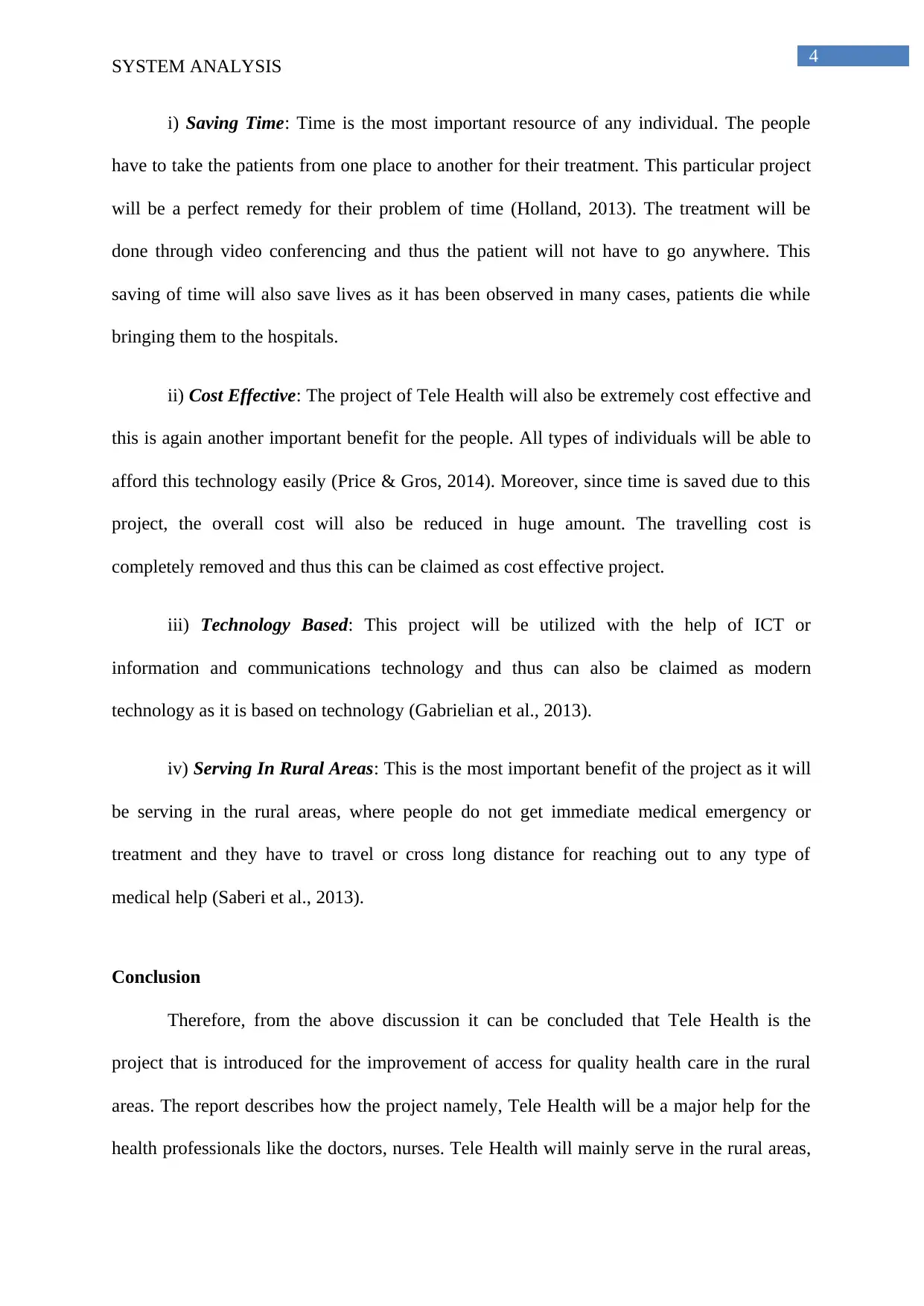
4
SYSTEM ANALYSIS
i) Saving Time: Time is the most important resource of any individual. The people
have to take the patients from one place to another for their treatment. This particular project
will be a perfect remedy for their problem of time (Holland, 2013). The treatment will be
done through video conferencing and thus the patient will not have to go anywhere. This
saving of time will also save lives as it has been observed in many cases, patients die while
bringing them to the hospitals.
ii) Cost Effective: The project of Tele Health will also be extremely cost effective and
this is again another important benefit for the people. All types of individuals will be able to
afford this technology easily (Price & Gros, 2014). Moreover, since time is saved due to this
project, the overall cost will also be reduced in huge amount. The travelling cost is
completely removed and thus this can be claimed as cost effective project.
iii) Technology Based: This project will be utilized with the help of ICT or
information and communications technology and thus can also be claimed as modern
technology as it is based on technology (Gabrielian et al., 2013).
iv) Serving In Rural Areas: This is the most important benefit of the project as it will
be serving in the rural areas, where people do not get immediate medical emergency or
treatment and they have to travel or cross long distance for reaching out to any type of
medical help (Saberi et al., 2013).
Conclusion
Therefore, from the above discussion it can be concluded that Tele Health is the
project that is introduced for the improvement of access for quality health care in the rural
areas. The report describes how the project namely, Tele Health will be a major help for the
health professionals like the doctors, nurses. Tele Health will mainly serve in the rural areas,
SYSTEM ANALYSIS
i) Saving Time: Time is the most important resource of any individual. The people
have to take the patients from one place to another for their treatment. This particular project
will be a perfect remedy for their problem of time (Holland, 2013). The treatment will be
done through video conferencing and thus the patient will not have to go anywhere. This
saving of time will also save lives as it has been observed in many cases, patients die while
bringing them to the hospitals.
ii) Cost Effective: The project of Tele Health will also be extremely cost effective and
this is again another important benefit for the people. All types of individuals will be able to
afford this technology easily (Price & Gros, 2014). Moreover, since time is saved due to this
project, the overall cost will also be reduced in huge amount. The travelling cost is
completely removed and thus this can be claimed as cost effective project.
iii) Technology Based: This project will be utilized with the help of ICT or
information and communications technology and thus can also be claimed as modern
technology as it is based on technology (Gabrielian et al., 2013).
iv) Serving In Rural Areas: This is the most important benefit of the project as it will
be serving in the rural areas, where people do not get immediate medical emergency or
treatment and they have to travel or cross long distance for reaching out to any type of
medical help (Saberi et al., 2013).
Conclusion
Therefore, from the above discussion it can be concluded that Tele Health is the
project that is introduced for the improvement of access for quality health care in the rural
areas. The report describes how the project namely, Tele Health will be a major help for the
health professionals like the doctors, nurses. Tele Health will mainly serve in the rural areas,
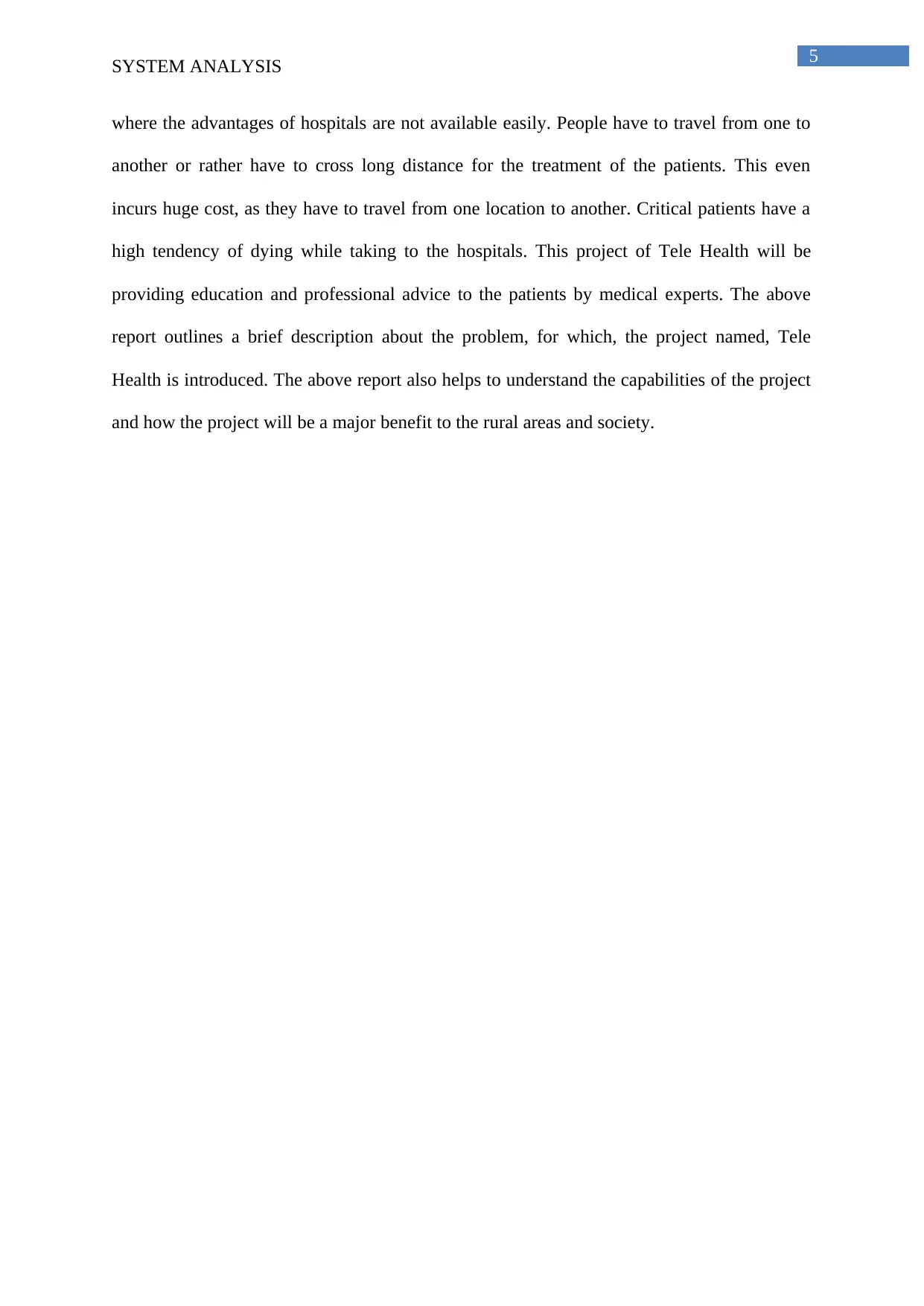
5
SYSTEM ANALYSIS
where the advantages of hospitals are not available easily. People have to travel from one to
another or rather have to cross long distance for the treatment of the patients. This even
incurs huge cost, as they have to travel from one location to another. Critical patients have a
high tendency of dying while taking to the hospitals. This project of Tele Health will be
providing education and professional advice to the patients by medical experts. The above
report outlines a brief description about the problem, for which, the project named, Tele
Health is introduced. The above report also helps to understand the capabilities of the project
and how the project will be a major benefit to the rural areas and society.
SYSTEM ANALYSIS
where the advantages of hospitals are not available easily. People have to travel from one to
another or rather have to cross long distance for the treatment of the patients. This even
incurs huge cost, as they have to travel from one location to another. Critical patients have a
high tendency of dying while taking to the hospitals. This project of Tele Health will be
providing education and professional advice to the patients by medical experts. The above
report outlines a brief description about the problem, for which, the project named, Tele
Health is introduced. The above report also helps to understand the capabilities of the project
and how the project will be a major benefit to the rural areas and society.
⊘ This is a preview!⊘
Do you want full access?
Subscribe today to unlock all pages.

Trusted by 1+ million students worldwide
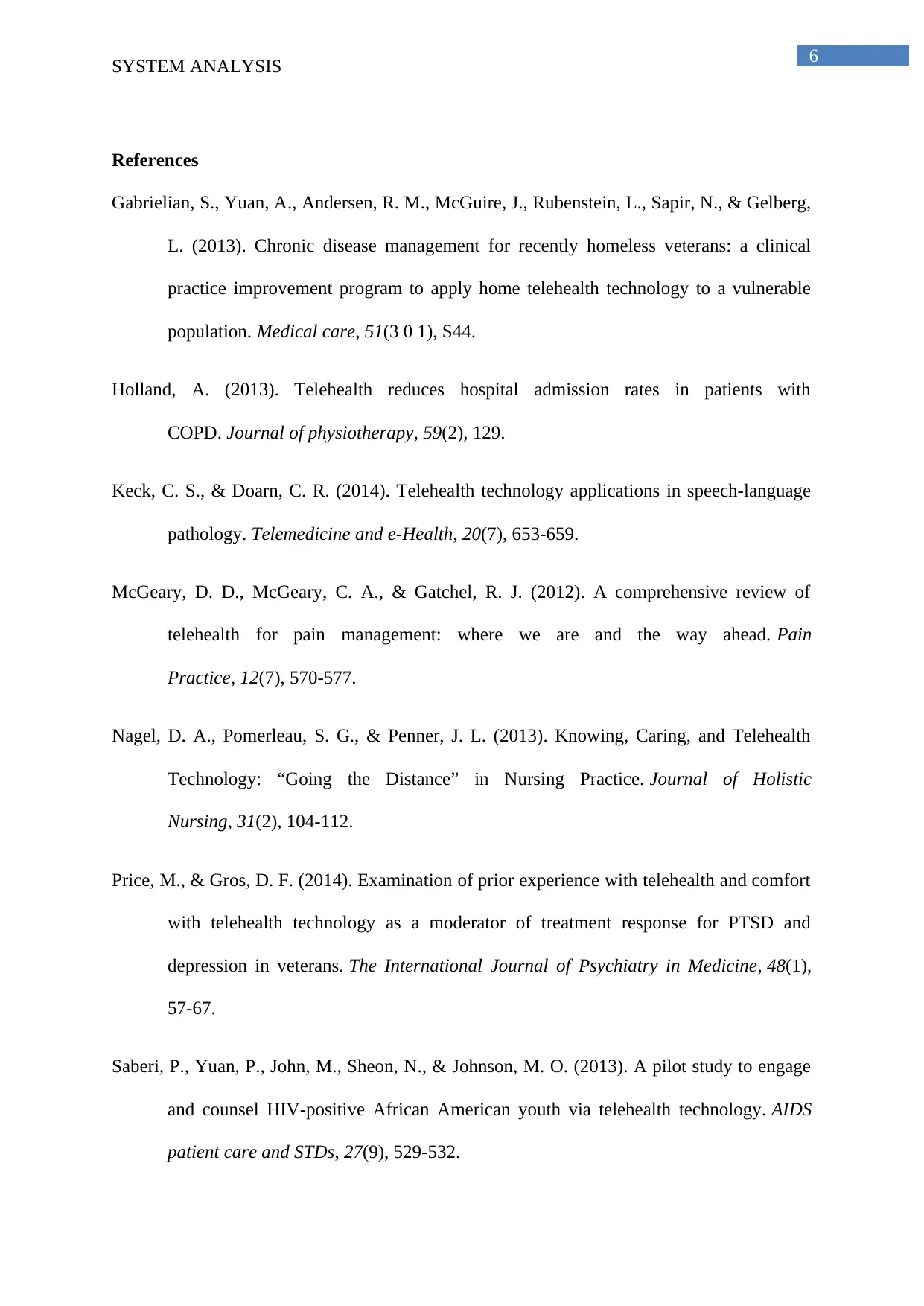
6
SYSTEM ANALYSIS
References
Gabrielian, S., Yuan, A., Andersen, R. M., McGuire, J., Rubenstein, L., Sapir, N., & Gelberg,
L. (2013). Chronic disease management for recently homeless veterans: a clinical
practice improvement program to apply home telehealth technology to a vulnerable
population. Medical care, 51(3 0 1), S44.
Holland, A. (2013). Telehealth reduces hospital admission rates in patients with
COPD. Journal of physiotherapy, 59(2), 129.
Keck, C. S., & Doarn, C. R. (2014). Telehealth technology applications in speech-language
pathology. Telemedicine and e-Health, 20(7), 653-659.
McGeary, D. D., McGeary, C. A., & Gatchel, R. J. (2012). A comprehensive review of
telehealth for pain management: where we are and the way ahead. Pain
Practice, 12(7), 570-577.
Nagel, D. A., Pomerleau, S. G., & Penner, J. L. (2013). Knowing, Caring, and Telehealth
Technology: “Going the Distance” in Nursing Practice. Journal of Holistic
Nursing, 31(2), 104-112.
Price, M., & Gros, D. F. (2014). Examination of prior experience with telehealth and comfort
with telehealth technology as a moderator of treatment response for PTSD and
depression in veterans. The International Journal of Psychiatry in Medicine, 48(1),
57-67.
Saberi, P., Yuan, P., John, M., Sheon, N., & Johnson, M. O. (2013). A pilot study to engage
and counsel HIV-positive African American youth via telehealth technology. AIDS
patient care and STDs, 27(9), 529-532.
SYSTEM ANALYSIS
References
Gabrielian, S., Yuan, A., Andersen, R. M., McGuire, J., Rubenstein, L., Sapir, N., & Gelberg,
L. (2013). Chronic disease management for recently homeless veterans: a clinical
practice improvement program to apply home telehealth technology to a vulnerable
population. Medical care, 51(3 0 1), S44.
Holland, A. (2013). Telehealth reduces hospital admission rates in patients with
COPD. Journal of physiotherapy, 59(2), 129.
Keck, C. S., & Doarn, C. R. (2014). Telehealth technology applications in speech-language
pathology. Telemedicine and e-Health, 20(7), 653-659.
McGeary, D. D., McGeary, C. A., & Gatchel, R. J. (2012). A comprehensive review of
telehealth for pain management: where we are and the way ahead. Pain
Practice, 12(7), 570-577.
Nagel, D. A., Pomerleau, S. G., & Penner, J. L. (2013). Knowing, Caring, and Telehealth
Technology: “Going the Distance” in Nursing Practice. Journal of Holistic
Nursing, 31(2), 104-112.
Price, M., & Gros, D. F. (2014). Examination of prior experience with telehealth and comfort
with telehealth technology as a moderator of treatment response for PTSD and
depression in veterans. The International Journal of Psychiatry in Medicine, 48(1),
57-67.
Saberi, P., Yuan, P., John, M., Sheon, N., & Johnson, M. O. (2013). A pilot study to engage
and counsel HIV-positive African American youth via telehealth technology. AIDS
patient care and STDs, 27(9), 529-532.
Paraphrase This Document
Need a fresh take? Get an instant paraphrase of this document with our AI Paraphraser
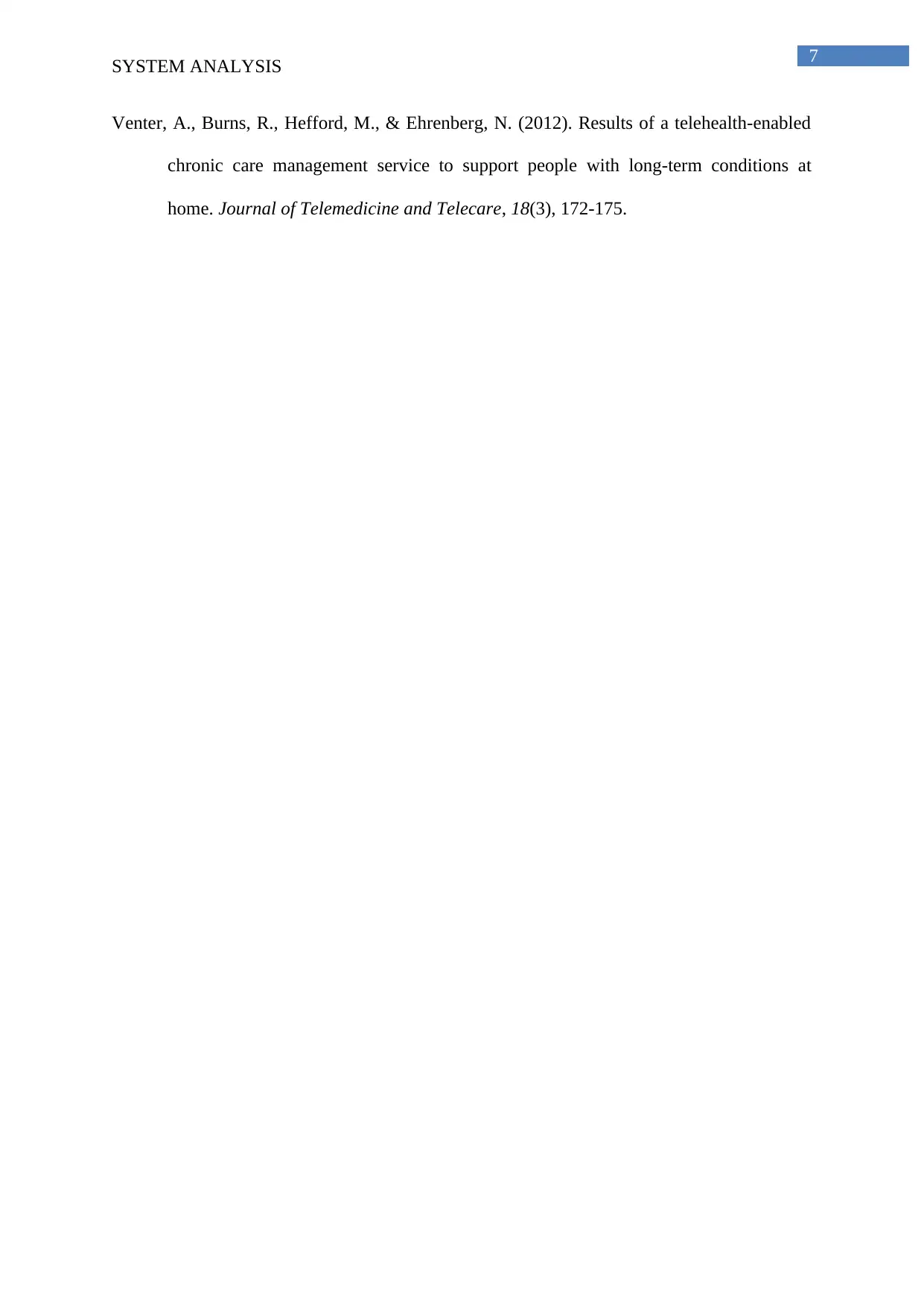
7
SYSTEM ANALYSIS
Venter, A., Burns, R., Hefford, M., & Ehrenberg, N. (2012). Results of a telehealth-enabled
chronic care management service to support people with long-term conditions at
home. Journal of Telemedicine and Telecare, 18(3), 172-175.
SYSTEM ANALYSIS
Venter, A., Burns, R., Hefford, M., & Ehrenberg, N. (2012). Results of a telehealth-enabled
chronic care management service to support people with long-term conditions at
home. Journal of Telemedicine and Telecare, 18(3), 172-175.
1 out of 8
Related Documents
Your All-in-One AI-Powered Toolkit for Academic Success.
+13062052269
info@desklib.com
Available 24*7 on WhatsApp / Email
![[object Object]](/_next/static/media/star-bottom.7253800d.svg)
Unlock your academic potential
Copyright © 2020–2025 A2Z Services. All Rights Reserved. Developed and managed by ZUCOL.




